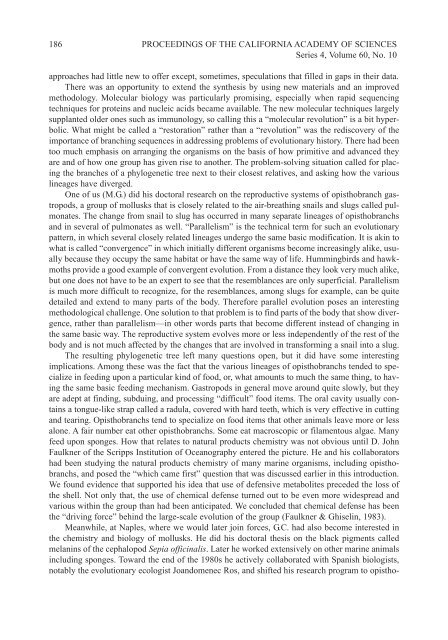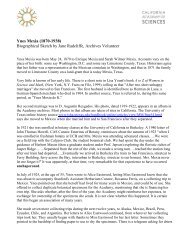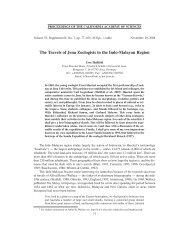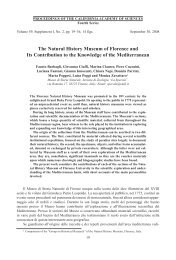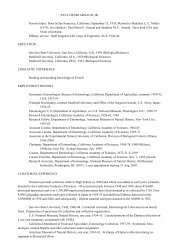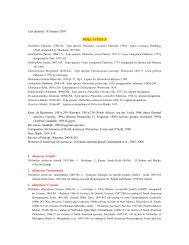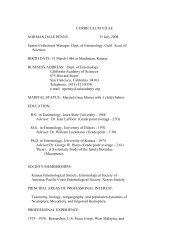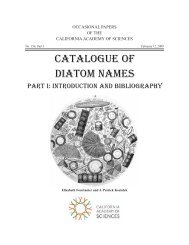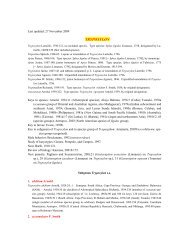Cimino&Ghiselin-tmpZXYZ:Template Proceedings_1.qxd.qxd
Cimino&Ghiselin-tmpZXYZ:Template Proceedings_1.qxd.qxd
Cimino&Ghiselin-tmpZXYZ:Template Proceedings_1.qxd.qxd
Create successful ePaper yourself
Turn your PDF publications into a flip-book with our unique Google optimized e-Paper software.
186 PROCEEDINGS OF THE CALIFORNIA ACADEMY OF SCIENCES<br />
Series 4, Volume 60, No. 10<br />
approaches had little new to offer except, sometimes, speculations that filled in gaps in their data.<br />
There was an opportunity to extend the synthesis by using new materials and an improved<br />
methodology. Molecular biology was particularly promising, especially when rapid sequencing<br />
techniques for proteins and nucleic acids became available. The new molecular techniques largely<br />
supplanted older ones such as immunology, so calling this a “molecular revolution” is a bit hyperbolic.<br />
What might be called a “restoration” rather than a “revolution” was the rediscovery of the<br />
importance of branching sequences in addressing problems of evolutionary history. There had been<br />
too much emphasis on arranging the organisms on the basis of how primitive and advanced they<br />
are and of how one group has given rise to another. The problem-solving situation called for placing<br />
the branches of a phylogenetic tree next to their closest relatives, and asking how the various<br />
lineages have diverged.<br />
One of us (M.G.) did his doctoral research on the reproductive systems of opisthobranch gastropods,<br />
a group of mollusks that is closely related to the air-breathing snails and slugs called pulmonates.<br />
The change from snail to slug has occurred in many separate lineages of opisthobranchs<br />
and in several of pulmonates as well. “Parallelism” is the technical term for such an evolutionary<br />
pattern, in which several closely related lineages undergo the same basic modification. It is akin to<br />
what is called “convergence” in which initially different organisms become increasingly alike, usually<br />
because they occupy the same habitat or have the same way of life. Hummingbirds and hawkmoths<br />
provide a good example of convergent evolution. From a distance they look very much alike,<br />
but one does not have to be an expert to see that the resemblances are only superficial. Parallelism<br />
is much more difficult to recognize, for the resemblances, among slugs for example, can be quite<br />
detailed and extend to many parts of the body. Therefore parallel evolution poses an interesting<br />
methodological challenge. One solution to that problem is to find parts of the body that show divergence,<br />
rather than parallelism—in other words parts that become different instead of changing in<br />
the same basic way. The reproductive system evolves more or less independently of the rest of the<br />
body and is not much affected by the changes that are involved in transforming a snail into a slug.<br />
The resulting phylogenetic tree left many questions open, but it did have some interesting<br />
implications. Among these was the fact that the various lineages of opisthobranchs tended to specialize<br />
in feeding upon a particular kind of food, or, what amounts to much the same thing, to having<br />
the same basic feeding mechanism. Gastropods in general move around quite slowly, but they<br />
are adept at finding, subduing, and processing “difficult” food items. The oral cavity usually contains<br />
a tongue-like strap called a radula, covered with hard teeth, which is very effective in cutting<br />
and tearing. Opisthobranchs tend to specialize on food items that other animals leave more or less<br />
alone. A fair number eat other opisthobranchs. Some eat macroscopic or filamentous algae. Many<br />
feed upon sponges. How that relates to natural products chemistry was not obvious until D. John<br />
Faulkner of the Scripps Institution of Oceanography entered the picture. He and his collaborators<br />
had been studying the natural products chemistry of many marine organisms, including opisthobranchs,<br />
and posed the “which came first” question that was discussed earlier in this introduction.<br />
We found evidence that supported his idea that use of defensive metabolites preceded the loss of<br />
the shell. Not only that, the use of chemical defense turned out to be even more widespread and<br />
various within the group than had been anticipated. We concluded that chemical defense has been<br />
the “driving force” behind the large-scale evolution of the group (Faulkner & <strong>Ghiselin</strong>, 1983).<br />
Meanwhile, at Naples, where we would later join forces, G.C. had also become interested in<br />
the chemistry and biology of mollusks. He did his doctoral thesis on the black pigments called<br />
melanins of the cephalopod Sepia officinalis. Later he worked extensively on other marine animals<br />
including sponges. Toward the end of the 1980s he actively collaborated with Spanish biologists,<br />
notably the evolutionary ecologist Joandomenec Ros, and shifted his research program to opistho-


